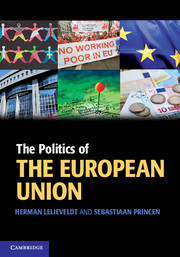Book contents
- Frontmatter
- Contents
- Acknowledgements
- List of briefings
- List of fact files
- List of controversies
- List of tables
- List of figures
- List of abbreviations and acronyms
- List of country abbreviations used in tables and figures
- Preface
- PART I Setting the scene: origins, analytical perspectives and institutions
- PART II Key actors in EU politics: citizens, interest groups and political parties
- 5 Public opinion and political participation
- 6 Interest groups and interest representation
- 7 Political parties and the European Parliament
- Part III EU policies: agenda-setting, decision-making and implementation
- Conclusions and reflections
- Key terms and concepts
- Index
5 - Public opinion and political participation
from PART II - Key actors in EU politics: citizens, interest groups and political parties
- Frontmatter
- Contents
- Acknowledgements
- List of briefings
- List of fact files
- List of controversies
- List of tables
- List of figures
- List of abbreviations and acronyms
- List of country abbreviations used in tables and figures
- Preface
- PART I Setting the scene: origins, analytical perspectives and institutions
- PART II Key actors in EU politics: citizens, interest groups and political parties
- 5 Public opinion and political participation
- 6 Interest groups and interest representation
- 7 Political parties and the European Parliament
- Part III EU policies: agenda-setting, decision-making and implementation
- Conclusions and reflections
- Key terms and concepts
- Index
Summary
Introduction
In the first week of June 2009 the citizens of the 27 EU member states headed to the polls to elect their representatives for the European Parliament. Although the BBC heralded the event as the ‘biggest transnational election in history’, the majority of the almost 400 million eligible voters stayed home. With only 43% of them going to the polls the election continued a trend of declining turnout ever since members for the EP were directly elected for the first time in 1979.
According to the Financial Times, those who did go to the polls ‘clearly opted for the safety of the right, because of the global economic downturn’. Many of the centre-right parties won seats or lost only a little, whilst many of Europe's social democratic parties suffered heavy losses. In the UK the Labour Party came in only third with a mere 15%. In Hungary the MSZP – the Hungarian socialist party – was almost halved and only gained 17% of the votes, a vote share similar to that of the Dutch labour party (the PvdA). The elections showed a strong performance of nationalistic, Eurosceptic parties, like the Dutch Freedom Party, the Hungarian Jobbik Party and UK's Independence Party, each of them gaining more than 10% of the votes.
- Type
- Chapter
- Information
- The Politics of the European Union , pp. 107 - 127Publisher: Cambridge University PressPrint publication year: 2011



